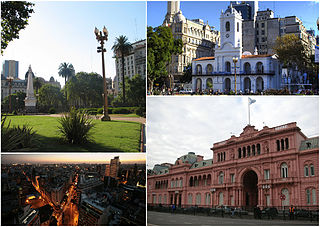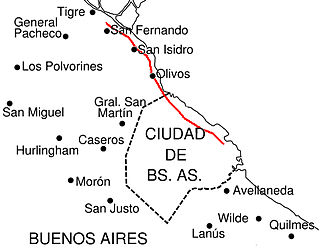Boedo Literary Group
The Boedo group were a group of left-leaning Argentine and Uruguayan writers in the 1920s. Notable members of the Boedo group included Enrique Amorim, Leónidas Barletta, Elías Castelnuovo, Roberto Mariani, Nicolás Olivari, Lorenzo Stanchina, César Tiempo, and Álvaro Yunque.
Magazines associated with the Boedo group included Dínamo, Extrema Izquierda and Los Pensadores, and Antonio Zamora's publishing house Claridad.
Olivari, who was a founder of the Boedo group, later became a member of the less political Florida group; Roberto Arlt was also associated with both groups.

San Telmo is the oldest barrio (neighborhood) of Buenos Aires, Argentina. It is a well-preserved area of the Argentine metropolis and is characterized by its colonial buildings. Cafes, tango parlors and antique shops line the cobblestone streets, which are often filled with artists and dancers. A street named the "Illuminated Block" is where many of these important historical buildings can be found.
The Florida group was an avant-garde literary-artistic group created in the 1920s in Buenos Aires, known by their embracing slogan "art for art's sake". The name refers to Florida Street, the location of a favored meeting point, the Richmond tea room.

Club Atlético San Lorenzo de Almagro, commonly known as San Lorenzo de Almagro or simply San Lorenzo, is a sports club of Argentina in the Boedo district of Buenos Aires. It is best known for its football team, which plays in the Primera División, the first tier of the Argentinian football league system. San Lorenzo is also considered one of the "big five" of Argentinian football, along with Independiente, River Plate, Boca Juniors, and Racing Club.

Recoleta is a barrio or neighborhood of Buenos Aires, Argentina, located in the northern part of the city, by the Río de la Plata. The area is perhaps best known to be the home of the distinguished Recoleta Cemetery. It is a traditional upper-class and conservative neighborhood, with some of the priciest real estate in the city.

Constitución is a barrio or neighborhood of Buenos Aires, Argentina, approximately two kilometers south of downtown.

Villa Crespo is a middle class neighborhood in Buenos Aires, Argentina, located in the geographical center of the city. It had a population of 83,646 people in 2001, and thus currently a population density of 23,235 inhabitants/km2. Villa Crespo celebrates its anniversary on June 3.

Almagro is a mostly middle-class barrio or neighbourhood of Buenos Aires, Argentina.

Nueva Pompeya, often loosely referred to as Pompeya, is a neighbourhood in the city of Buenos Aires, Argentina. Located in the South side, it has long been one of the city's proletarian districts steeped in the tradition of tango and one where many of the first tangos were written and performed.

Avenida Corrientes is one of the principal thoroughfares of the Argentine capital of Buenos Aires. The street is intimately tied to the tango and the porteño sense of identity. Like the parallel avenues Santa Fe, Córdoba, and San Juan, it takes its name from one of the Provinces of Argentina.

The Estadio Pedro Bidegain, more often known as El Nuevo Gasómetro, is the home stadium of Club San Lorenzo, located in Bajo Flores neighborhood of Buenos Aires city.

The San Lorenzo de Almagro Stadium was a football stadium located in the neighborhood of Boedo in Buenos Aires. Inaugurated in 1916, the stadium was the home ground of club San Lorenzo de Almagro before they moved to their new venue, Estadio Pedro Bidegain, which is sometimes referred to as "Estadio Nuevo Gasómetro", in 1993. The stadium had a capacity of 75,000 people.

Flores is a middle-class barrio or district in the center part of Buenos Aires city, Argentina. Flores was considered a rural area of the Province of Buenos Aires until 1888 when it was integrated into the city. Flores is the birthplace of Pope Francis.

Vélez Sársfield is a barrio or district in the western part of Buenos Aires, Argentina, located in the area defined by the streets Segurola Avenue, Juan Agustín García, Lope de Vega Avenue, Juan B. Justo Ave., Corro Ave., Medina, Juan Bautista Alberdi Ave. and Mariano Acosta.

Monserrat or Montserrat is a neighbourhood in the east of the Buenos Aires CBD. The district features some of the most important public buildings in Buenos Aires, including city hall, the city legislature, Casa Rosada, the Colegio Nacional de Buenos Aires and the Libertador Building, among others.

Villa Pueyrredón is a neighbourhood of Buenos Aires, the capital of Argentina. It is located between the neighborhoods of Villa Urquiza, Villa Devoto, and Agronomía. It is a middle class residential neighborhood with streets in draught-board, and surrounded by many squares and parks. The General Mitre Railway links Villa Pueyrredon with Retiro railway station in Buenos Aires CBD.
Sur ("South") is an Argentine tango with music by Aníbal Troilo and lyrics by Homero Manzi. It was first recorded by Troilo's orchestra with vocals by Edmundo Rivero on 23 February 1948. The first live performance, by the same artists, was at the Tibidabo night club in Buenos Aires.

Avenida del Libertador is one of the principal thoroughfares in Buenos Aires, Argentina, and in points north, extending 25 km (16 mi) from the Retiro District of Buenos Aires to the northern suburb of San Fernando.

Juan de Dios Filiberto was an Argentine violinist, conductor, poet and composer who became prominent in the Argentine tango genre.

Club Atlético San Lorenzo de Almagro is the men's professional club basketball section of the homonymous sports club based in Buenos Aires, Argentina. The team plays in the Liga Nacional de Básquet (LNB), which is the first tier level division of the Argentine basketball league system, and Pan-America's premier men's basketball league, the Basketball Champions League Americas. Their home arena is the Estadio Ciudad de Santiago del Estero. The team is currently coached by Silvio Santander. In the period 1942-1973, he stood out for what he did at the amateur and semi-amateur level, in which he won 29 regional titles, won the Argentine Club Championship, and was South American runner-up in 1958. In addition, he was one of the founding clubs of the National League, playing the opening game of said tournament on April 26, 1985. Although the club is known mainly for its soccer part, it is also one of the most important basketball clubs in the country and South America, being a multi-champion at various times in its history. He has to his credit five Leagues, two Liga de las Américas, and other titles such as a Super 4, and two Super Cups. San Lorenzo is the first, and so far, the only Argentine basketball team to face an NBA team. It is the only club that has been four-time and five-time champion of the National League.
Osvaldo J. Peredo was an Argentine tango singer. He was a follower of Carlos Gardel. He is credited with the renaissance of the tango in Argentina.




















